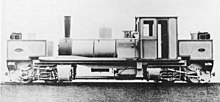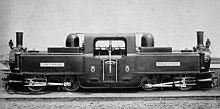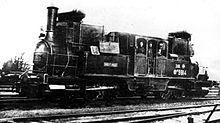Fairlie (locomotive)
A steam locomotive of the type Fairlie is an articulated or double locomotive with two motor bogies and a double boiler with a smoke chamber and a chimney at each end of the locomotive. The driver's cab is in the middle of the locomotive. The locomotives are also known as Double Fairlie , to distinguish them from the derived design Single Fairlie .
Fairlies are by Robert Francis Fairlie named (1831-1885) and made the first practical design of articulated locomotives are but you could not hold up against more modern designs and have only until the end. First World War built - with the exception of two new buildings of the Ffestiniog Railway for museum use towards the end of the 20th century.
history
Probably the first articulated locomotive ever, built in 1832 for the Charleston & South Carolina Rail Road , can also be seen as the origin of the Fairlie design: The symmetrically constructed locomotive had two bogies , a fire box and a driver's cab in the middle of the locomotive. Otherwise, however, it was a very unusual construction, with two boiler sections on each side, between which a cylinder was arranged. Overall, the locomotive with the wheel arrangement (1A) (A1) only had two cylinders. Details are scarce, but it seems unlikely that the locomotive was successful.
The Seraing by Cockerill , built in 1851 for the competition announced by the Semmering Railway , on the other hand, resembled the "modern" Fairlies in its basic structure. The Seraing however had, unlike later Fairlie, a continuous main frame on which the couplings were attached. The kettle had an oval cross-section; the cylinders were arranged inside the bogie frame . The locomotive achieved third place in the competition and was taken over by the railway. However, it was primarily the leakage problems of the moving steam lines that prevented long-term use, and the locomotive was soon shut down. Disappointed, Cockerill did not pursue this concept any further.
Robert Fairlie took up the idea again more than ten years later and had the principle patented in 1864, the only major difference between his concept and the seraing being that the couplings were attached to the bogies of the vehicles and no longer to the main frame. Fairlie's intention was to use the full weight of a locomotive for traction, so all axes to drive, while also creating a locomotive with sufficient inventories, could pass through the tight corners without a Tender got along and are therefore not rotated at the ends of the track had to. The first locomotive built according to this patent went to the Neath and Brecon Railway in 1865 . It did not prove itself because it only had one fire box in which the induced draft from one smoke chamber worked against that from the other.
The narrow-gauge Ffestiniog Railway (FR) was faced with the decision to double-track its line at this time due to the sharp increase in traffic . As a cheaper alternative, there was a Fairlie locomotive, with which the train lengths could be increased significantly. In 1869, Fairlie, who had taken over the locomotive factory from George England (the builder of the former FR locomotives), delivered the Little Wonder locomotive . Test runs showed that this locomotive could pull more than twice as much as the two-axle England machines, and the railway procured three more Fairlies ( James Spooner , Merddin Emrys and Livingston Thompson ) in the following years , the last two in the railway's own workshops originated. In addition, a single fairlie was procured, in principle a half fairlie with only one motor bogie and a simple running bogie.
The Vulcan Foundry built several fairlies from 1872, initially for New Zealand and Peru . Fairlies were also used temporarily in Mexico and other countries, but could not last very long anywhere. In Russia , 45 Fairlies of the series Ф drove on the Transcaucasian Railway and were indispensable there for decades due to the steep and curving mountain range of the Surami Pass. Ultimately, the Ffestiniog Railway remained the only railway in the world on which Fairlies have proven themselves to this day.
Structure and technology

A fairlie has a double kettle, that is, a kettle with the standing kettle in the middle between the two long kettles . In this standing boiler there are two separate fire boxes through which the flue gases flow through the heating pipes of the long boiler to the smoke chambers , each with a chimney at each end of the boiler. The fire doors to the fire boxes are on the stoker's side of the boiler (the stoker and engine driver stand on both sides of the locomotive and are separated from one another by the standing boiler).
Usually there are two steam domes , e.g. B. in Saxon I M . In each steam dome there is a steam regulator with which the steam can be directed to the motor bogie below. The French version Péchot-Bourdon , which goes back to its own patent, has only a central steam dome on the standing boiler as a characteristic feature, but still has two controls, one for each motor bogie (according to: Péchot-Bourdon). The still existing Fairlie locomotives have several variants for operating the two controllers. With the Sächsische I M , both controllers are permanently connected to each other. With the Péchot-Bourdon locomotive, the two controllers can optionally be mechanically linked. Or the operating handles for the two controls are attached so that they can be operated with one hand at the same time, like the "Earl of Merioneth" locomotive on the Festiniog Railway .
The boiler of a fairlie rests on a bridge frame, which is supported at both ends on a bogie . The steam is supplied via movable lines between the smoke chambers and the valve boxes of the cylinders arranged at the locomotive ends (an exception in this regard is the Saxon I M , in which the cylinders are mounted on the inside of the locomotive). The wheel arrangement of most of the Fairlies was B'B 'or C'C', i.e. H. all axles were driven. However, some Fairlies also had running axles, i.e. the axle sequences (1'B) (B1 ') or (1'C) (C1').
The water tanks are located on the sides of both long boilers. On the heater side, coal boxes (or oil tanks) are integrated into these tanks on both sides of the driver's cab. The Fairlies of the Transcaucasian Railway originally had firewood firing. The locomotives had lattice containers on the boiler, which reached from the driver's cab to the smoke chamber . Later they too were converted to oil firing. The water tanks of the Ffestiniog-Fairlies are connected to each other under the driver's cab by a tub-like part that visually fills the space between the bogies. Some larger Fairlies had additional containers above the boiler in front of and behind the cab.
The Burma Railway Fairlie shown on the right for use on the Mandalay – Lashio line differs from the usual design: It has two independent boilers, so that the engine driver and stoker are no longer separated. The disadvantage is the need to regulate the water level and pressure in both boilers independently of one another.
Comparison with other types of joint

As with all articulated locomotives, a disadvantage of Fairlie is its greater complexity and the associated greater maintenance costs. However, this is put into perspective if you compare the cost of an articulated locomotive with the cost of two conventional locomotives that can replace an articulated locomotive. The problems with the moving steam pipes remain, the sealing of which caused considerable problems, especially in the 19th century.
The Fairlie was initially in competition with the Mallet and Meyer types . One advantage over these types of construction was that the Fairlie's fire box and ashtray were hardly restricted in size because of their arrangement between the two bogies and the latter could practically reach down to the rails. With the Kitson-Meyer and finally the Garratt , this principle was later also implemented with a simple boiler.
In addition to the fundamental complication that results from the double presence of boiler components, a major disadvantage of Fairlie is the tight space for the train driver and especially the stoker. This problem was exacerbated as the boiler diameter increased, while at the same time the space for the water and coal supplies decreased, so there is a practical upper limit to the size of fairlies. The largest fairlies, built for the Ferrocarril Mexicano (FCM), were oil-fired, which meant that the heater could get by with less space.
The bogies of the Fairlies tend to roll - like those of Meyer locomotives and smaller mallets - because the forces due to the reciprocating masses of the cylinders are relatively large in relation to the weight of the bogies. This problem was solved with the Garratt, in which the coal and water boxes were built on the bogies and thus increased their weight.
While the Meyer in the form of the Kitson-Meyer can be seen as the forerunner of the Garratt, the Fairlie has not undergone any further development. The so-called Modified Fairlie is a variant of the Kitson-Meyer that is more like a Garratt than a Fairlie.
Preserved locomotives

Few fairlies have survived, and four of them are connected to the Ffestiniog Railway. The railway has had three copies in use since the 1990s: The Merddyn Emrys dates from 1879, but has been rebuilt several times and equipped with a modern boiler. The other two, Earl of Merioneth and David Lloyd George , are new builds from 1979 and 1992, although parts of older locomotives were used. A fourth locomotive, Livingston Thompson , which was taken out of service in 1971 , is in the National Railway Museum in York.
Josephine , one of the locomotives delivered to New Zealand in 1872, is kept in the Otago Settlers Museum in Dunedin .
One Péchot Bourdon locomotive is in the Dresden Transport Museum and one in Požega (Serbia) ; a Saxon I M is also part of the collection of the Dresden Transport Museum, it is stationed on permanent loan in Oberheinsdorf near Reichenbach in the Vogtland .
Individual evidence
- ^ AE Durrant: Garratt Locomotives of the World. Birkhäuser Verlag ISBN 3-7643-1481-8 , p. 10
- ↑ Photograph of the Merddin Emrys with the driver's cab removed. You can see the bridge frame and the heater side of the boiler with two fire doors.
- ↑ http://www.gillbachbahn.de/pechot/p600/p40.jpg
- ↑ http://www.buntbahn.de/fotos/data/9012/80Sommer-2013_2013-06-25_5107.jpg
literature
- Ober-Ing. Gebauer: Fairlie's patented locomotive system and its influence on the cheaper operation of railways, especially vicinal railways. In: Polytechnisches Journal . 196, 1870, pp. 392-405.
Web links
- [1] (English)








